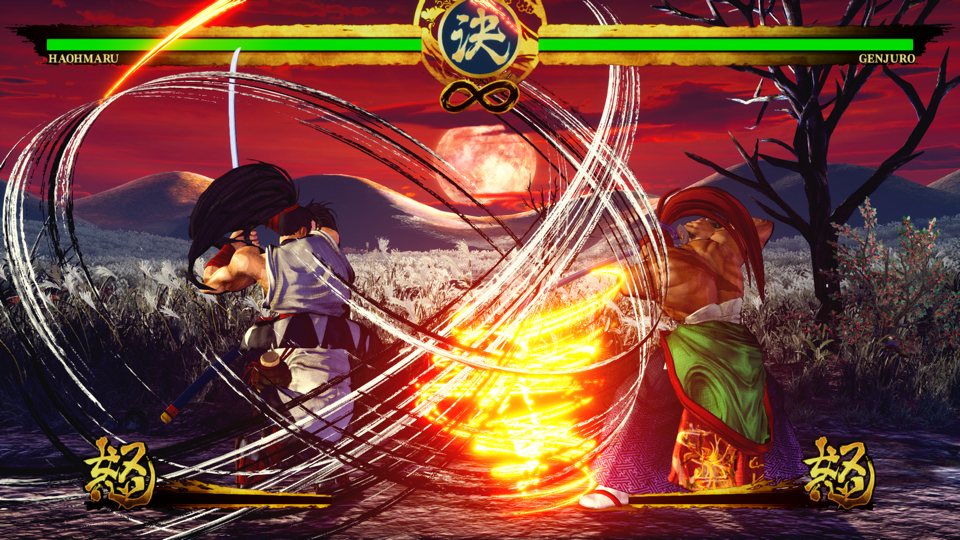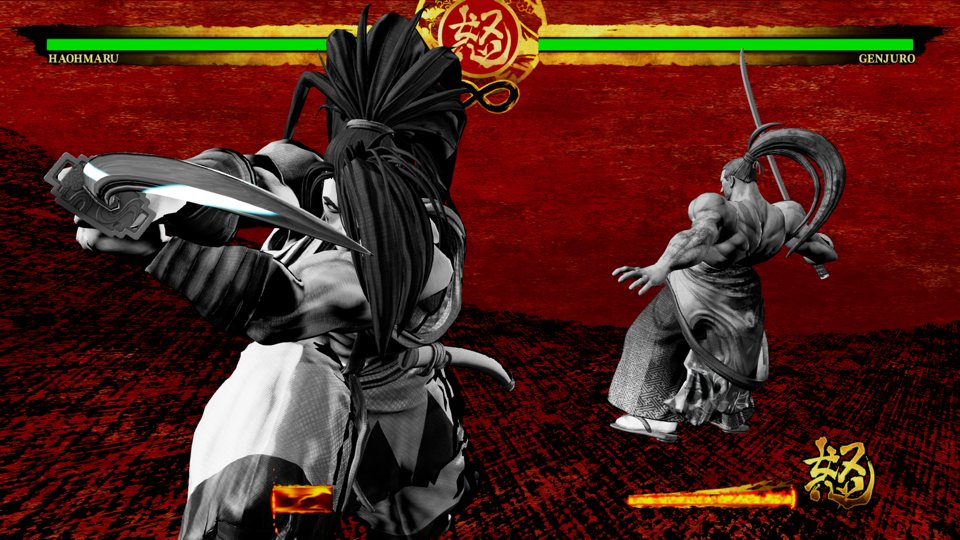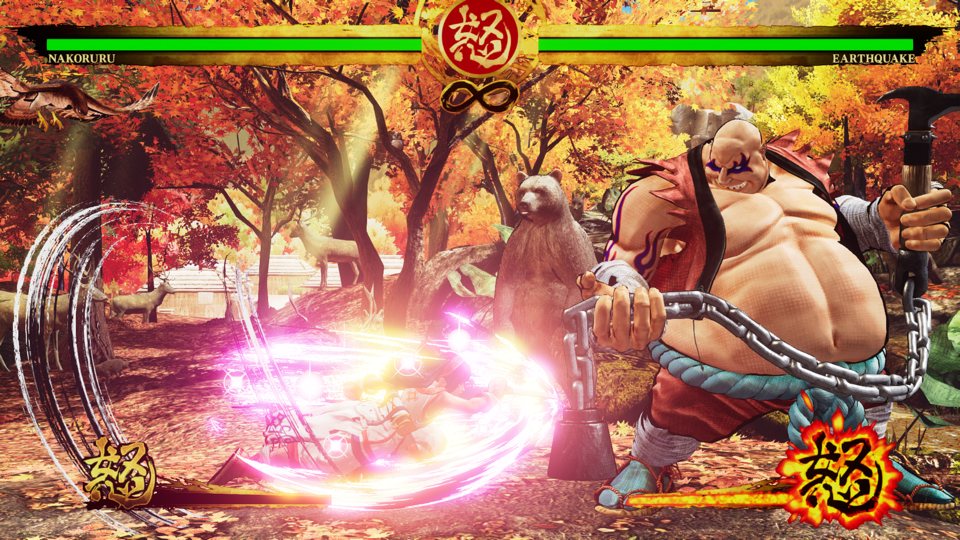Genjuro stands there sword in hand, poised for attack. His opponent, Haohmaru the wandering swordsman, gives a wry smile before charging in to deliver the final blow to Genjuro. Genjuro, however, had one last trick up his sleeve. He summons his inner strength and enters a state of exploding rage, enabling him to perform the ‘Lightning Blade’ technique, fabled amongst warriors of his era. The sky flashes red and Genjuro is suddenly behind Haohmaru, sword outstretched, covered in blood. Haohmaru clutches his chest, but it’s too late. Blood gushes skywards from Haohmaru’s chest and he falls to his knees, his life flashing before his eyes.
At this point, I nearly threw my controller in excitement. This is exactly what I was hoping for in SNK’s upcoming reboot of Samurai Showdown. A chance to duel like a distinguished human being, showing respect for my opponent in the ultimate form of combat.
One of the things that set Samurai Showdown apart from other fighters is the emphasis on big hits. A fight can be won in just five heavy attacks, leaving you with little room for error. It’s a fighting game that rewards patience and really makes you appreciate people that do it professionally in tournaments like EVO. The mere fact that Samurai Showdown is in the 2019 EVO line up is telling; people already have faith in it and it’s completely justified from what I’ve seen.
I spent four hours trying out the seven characters on offer – Haohmaru, Nakoruru, Jubei Yagyu, Galford, Genjuro Kibagami, Earthquake and Charlotte – going through each character’s two fight story missions and getting a few rounds against other players.
Samurai Showdown is a good fighter for people new to the genre and pros alike. The focus on heavy hitting attacks means you don’t have to spend hours learning massive thirty hit combos before feeling like you stand a chance. Each character, of course, has their gimmicks, but it’s less frightening for casual players hoping to up their game and tilt at the pros. Yasuyuki Oda, the producer of Samurai Showdown even thinks I have a chance at EVO, and he watched me play!

Four face buttons give you light, medium and heavy weapon attacks with the fourth being reserved for kicks – excellent if you lose your weapon mid-match. Special moves are available for each character, but present much less of a danger compared to simply being caught by a heavy attack out of the blue. Unlike other fighters, there’s less of a chance of being fireball spammed in a corner, and much more of an incentive to land a few crushing blows.
I initially went with the face of the series, Haohmaru, a wandering swordfighter based on famed swordsman Miyamoto Musashi, and my first instinct was to go straight for the special moves list. I was soon conditioned in this game’s different style of fighting. This is all about two duelists staring each other down, waiting for the other to make a mistake. It’s the ultimate game of footsies. That doesn’t mean specials are redundant. They definitely have their place as I quickly found, utilising Haohmaru’s dragon punch style rising sword slash to anti-air my opponent when they jumped in.
You’re encouraged to up your defensive game as well, because just holding back to block will not yield the best results, not least because a guard break can shove you back and open you up for quick light attacks. By timing your block you can trigger a ‘just defence’, which will force them on the back foot or leave them open to your counterattack for a split second. You can also dodge, making your opponent completely miss as your character steps smartly to the side, but if used in combination with a ‘just defence’, it will knock your opponent off their feet, taking away your chance for an immediate follow-up attack, but giving you ample time to get in position for a set up in your favour.
My favourite of all the defence techniques was the counter – a quarter circle forward and dodge – which if timed correctly, leaves your opponent wide open and sometimes even knocks their weapon out of their hand. If you happen to have lost your weapon mid-fight, the counter will always perform a ‘blade catch’ disarm, evening up the fight as you catch their weapon and then (for some reason) throw it away. Pulling this move off, I again nearly launched my controller across the room in excitement. It’s the kind of ninja assassin craziness you’re used to seeing on old martial arts movies. You feel like a boss!

Disarming your opponent can definitely turn the tide of battle, but it’s not the end. You can still pick your weapon up off the ground, so long as your opponent isn’t trying to keep you away from it. The best (and easiest) way of disarming your opponent is via your weapon flipping technique – a powerful attack which can be utilised when your resource bar is full – or when you are in Rage Explosion. Like most big moves, the weapon flipping technique can be telegraphed, but just you watch your opponents face when you disarm them and deal a big chunk of damage in the process.
Once per match you can activate Rage Explosion, a mode that has two benefits. Firstly, it powers up certain moves, changing their properties and adding extra damage. Secondly, it gives you access to the ‘Lightning Blade’ attack, which sees your character charge across the screen and perform a lightning fast slash, turning the screen red and dealing a massive amount of damage to your opponent. The camera will shift to a classic shot of your character stood, weapon outstretched as your opponent bleeds. It’s very anime. It’s very awesome.
If there weren’t enough tools already, you also have a ‘Super Special Move’ which can be used once per match and deal around 80% of an opponent’s health bar. I was stunned. I hit poor Nakoruru a couple of times with a medium attack, activated my Super and ended the fight. Given the damage output available to you, the speed of the matches is incredible. If you time it correctly, landing certain moves during a final blow will actually result in you cleaving them in half, which was also pretty awesome.

I ended up really liking the very cool looking Genjuro Kibagami and the hulking Earthquake. Of all the sword wielders, Genjuro felt really nice to play, with his rekka style slashes that zipped to both sides of his opponent before delivering a big strike. Earthquake was imposing, taking up a lot of the screen as he cuts about, breathing fire, performing teleporting belly flops and generally making mincemeat out of his enemies. It left one of the other guys at the preview in dismay trying to figure out my Earthquake game, as I laughed internally because I’m a massive git. Despite these two being my favourites, there wasn’t a character I didn’t like, they all felt nice to play and each had their own gimmick which I’m sure will be quickly mastered by pros.
The game is also gorgeous! Presented in a gorgeous Japanese brushed art style seen in the likes of Street Fighter IV, Samurai Showdown feels like it’s sticking very close to its roots and it really makes it stand out alongside other established fighters. But why a reboot? “Because It’s been requested by the fans and it’s also it’s a good way to introduce new people to the series,” said producer Yasuyuki Oda and I happen to agree.
Fans of the series will not be disappointed with Samurai Showdown as it retains a lot of what people loved about the original, but can also serve as a jumping on point for newcomers who don’t want to worry about its history. If it’s looking this good now, I cannot wait to see what the finished product looks like.

